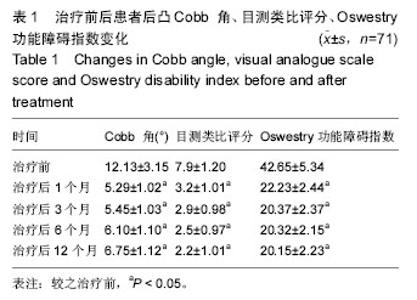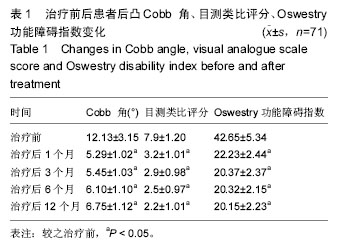Chinese Journal of Tissue Engineering Research ›› 2016, Vol. 20 ›› Issue (31): 4603-1609.doi: 10.3969/j.issn.2095-4344.2016.31.006
Previous Articles Next Articles
Biocompatibility of Sextant minimally invasive pedicle screw fixation for osteoporotic vertebral fractures in the elderly
Wu Jian-jun
- Department of Spine Surgery, Ninth Ward, Department of Orthopedics, Fuzhou Second Hospital Affiliated to Xiamen University, Fuzhou 350007, Fujian Province, China
-
Revised:2016-05-10Online:2016-07-22Published:2016-07-22 -
About author:Wu Jian-jun, Associate chief physician, Department of Spine Surgery, Ninth Ward, Department of Orthopedics, Fuzhou Second Hospital Affiliated to Xiamen University, Fuzhou 350007, Fujian Province, China
CLC Number:
Cite this article
Wu Jian-jun. Biocompatibility of Sextant minimally invasive pedicle screw fixation for osteoporotic vertebral fractures in the elderly[J]. Chinese Journal of Tissue Engineering Research, 2016, 20(31): 4603-1609.
share this article
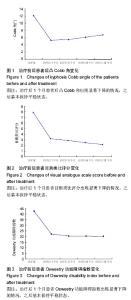
2.1 参与者数量分析及随访情况 按意向性处理,术后随访12个月,入组的71例患者均顺利完成随访,随访率为100%,并全部进入最终的结果分析。 2.2 手术一般情况 入组患者均顺利完成手术治疗,平均手术时间90.25 min,术中出血量85.15 mL。 2.3 治疗前后患者后凸Cobb角、目测类比评分、Oswestry功能障碍指数比较 治疗后不同时间对患者的后凸Cobb角、目测类比评分、Oswestry功能障碍指数进行统计,可以发现各项指标均在治疗后1个月出现显著下降的情况,之后基本保持平稳状态,见图1-3。其中治疗后1,3,6,12个月的后凸Cobb角、目测类比评分、Oswestry功能障碍指数均显著小于治疗前(P < 0.05),且治疗后不同时间各项指标差异均无显著性意义(P > 0.05),见表1。"
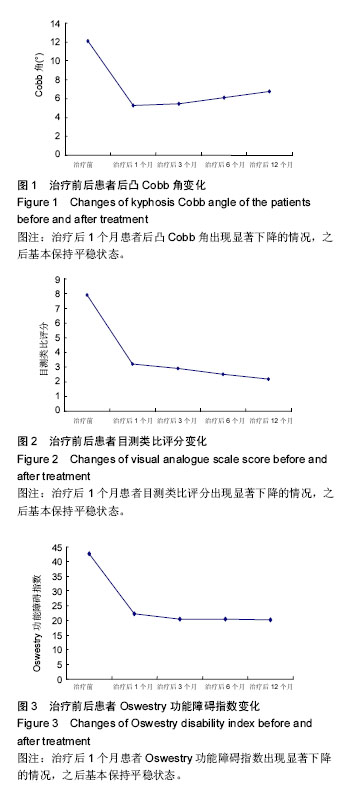
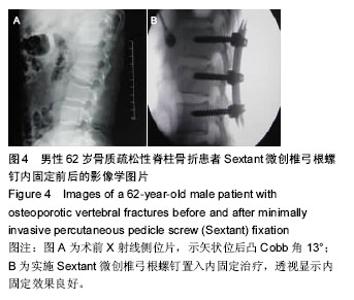
2.4 内固定置入后并发症 术后有2例患者出现切口感染,经积极对症治疗后痊愈,未出现血栓、深静脉血栓以及断钉等其他并发症。 2.5 患者取钉时大体观察 术后取钉时,对患者内固定周围组织情况进行观察,内固定周围未出现软组织炎性增生现象,且未观察到纤维囊壁形成和组织变黑等情况。 2.6 典型病例分析 男性患者,62岁,背部疼痛入院治疗。经诊断为骨质疏松性为脊柱骨折,术前X射线侧位片示矢状位后凸Cobb角13°(见图4A)。征得患者及其家属知情同意之后,实施Sextant微创椎弓根螺钉置入内固定治疗,透视显示内固定效果良好(见图4B)。术后随访12个月,患者术后后凸Cobb角、目测类比评分、Oswestry功能障碍指数均在治疗后1个月出现显著下降的情况,之后基本保持平稳状态。术后切口一期愈合,未出现切口感染等情况。术后取钉时,内固定周围未出现软组织炎性增生现象,且未观察到纤维囊壁形成和组织变黑现象。"

| [1] 匡勇,俞仲翔,常跃文,等.骨质疏松性腰椎骨折合并脊髓损伤的手术治疗[J].脊柱外科杂志,2008,6(5):265-267. [2] 杨晟,郑文标,东方财,等.Sextant微创椎弓根螺钉内固定系统治疗老年骨质疏松性脊柱骨折的临床疗效分析[J].浙江创伤外科,2014,19(5):748-749. [3] 杨雷.经皮椎弓根钉螺钉的基础和应用研究[D].第二军医大学,2003. [4] 董顺斌.Sextant经皮微创脊柱内固定系统在胸腰椎骨折中的应用及其解剖学基础[D].浙江大学,2007. [5] 郝定均,贺宝荣,刘团江,等.应用空心螺钉固定治疗骨质疏松性胸腰段脊柱骨折的近期效果[J].中国脊柱脊髓杂志, 2005,15(7):414-416. [6] 牛国旗,杨惠林,刘振华,等.后凸成形术经皮穿刺与椎弓根螺钉植入内倾角的影像学研究[J].中华骨科杂志, 2008, 28(12):1019-1023. [7] Masala S, Nano G, Marcia S,et al.Osteoporotic vertebral compression fractures augmentation by injectable partly resorbable ceramic bone substitute (Cerament?|SPINE SUPPORT): A prospective nonrandomized study.Neuroradiology. 2012;54(6): 589-596. [8] Nieuwenhuijse MJ, Putter H, van Erkel AR, et al.New Vertebral Fractures after Percutaneous Vertebroplasty for Painful Osteoporotic Vertebral Compression Fractures: A Clustered Analysis and the Relevance of Intradiskal Cement Leakage. Radiology. 2013;266(3): 862-870. [9] 陈方经,欧阳跃平.老年骨质疏松性脊柱骨折治疗进展[J].国际骨科学杂志,2010,31(3):164-165,168. [10] 钟小明,胡侦明,郝杰,等.骨质疏松椎体椎弓根螺钉内固定研究进展[J].中国脊柱脊髓杂志,2010,20(9):779-782. [11] Bednar T, Heyde CE, Bednar G, et al. Kyphoplasty for vertebral augmentation in the elderly with osteoporotic vertebral compression fractures: Scenarios and review of recent studies. Clin Ther. 2013;35(11):1721-1727. [12] 檀臻炜,姚一民,匡红,等.经椎弓根植入生物人工材料骨诱导人工骨加内固定治疗骨质疏松性胸腰段骨折[J].中华创伤杂志,2012,28(6):505-508. [13] 白成瑞,唐海.骨质疏松性脊柱骨折治疗的现状与展望[J].中国骨质疏松杂志,2007,13(10):754-757. [14] Movrin I, Vengust R, Komadina R, et al.Adjacent vertebral fractures after percutaneous vertebral augmentation of osteoporotic vertebral compression fracture: a comparison of balloon kyphoplasty and vertebroplasty. Arch Orthop Trauma Surg. 2010;130(9): 1157-1166. [15] Brodano GB,Colangeli S,Babbi L, et al.Osteoporotic vertebral fractures: a disabling and expensive disease of our century. A minimally invasive surgical technique to reduce the pain, the hospitalization, and restore the function. Eur Rev Med Pharmacol Sci. 2011;15(12): 1473-1477. [16] Diel P, Freiburghaus L, Röder C, et al. Safety, effectiveness and predictors for early reoperation in therapeutic and prophylactic vertebroplasty: short-term results of a prospective case series of patients with osteoporotic vertebral fractures. Eur Spine J. 2012; 21(Suppl.6):S792-S799. [17] 牛国旗.后凸成形术治疗骨质疏松性椎体压缩骨折的实验与临床研究[D].苏州大学,2006. [18] 张淑玲,张福琴,朱建华,等.空心螺钉治疗骨质疏松合并胸腰段脊柱骨折的术后护理[J].实用医技杂志, 2007, 14(17): 2367-2368. [19] Rousing R,Hansen KL,Andersen M, et al.Twelve-months follow-up in forty-nine patients with acute/semiacute osteoporotic vertebral fractures treated conservatively or with percutaneous vertebroplasty: a clinical randomized study. Spine. 2010;35(5):478-482. [20] Roussy JP, Bessette L, Bernatsky S, et al. Biologic disease-modifying anti-rheumatic drugs and the risk of non-vertebral osteoporotic fractures in patients with rheumatoid arthritis aged 50 years and over. Osteoporos Int. 2013;24(9):2483-2492. [21] 徐龙伟,季卫平,李浩,等.老年骨质疏松性不稳定胸腰椎骨折的手术治疗[J].临床骨科杂志,2010,13(1):19-21. [22] Nieuwenhuijse MJ, van Rijswijk CS, van Erkel AR, et al. The intravertebral cleft in painful long-standing osteoporotic vertebral compression fractures treated with percutaneous vertebroplasty: Diagnostic assessment and clinical significance. Spine. 2012; 37(11):974-981. [23] Baum T, Müller D, Dobritz M, et al. Converted lumbar BMD values derived from sagittal reformations of contrast-enhanced MDCT predict incidental osteoporotic vertebral fractures. Calcif Tissue Int. 2012; 90(6):481-487. [24] Li X, Yang H, Tang T, et al. Comparison of kyphoplasty and vertebroplasty for treatment of painful osteoporotic vertebral compression fractures: Twelve-month follow-up in a prospective nonrandomized comparative study. J Spinal Disord Tech. 2012;25(3):142-149. [25] 成翔宇,纪斌,庞金辉,等.骨折的生物学内固定及内固定材料性能分析[J].中国组织工程研究,2012,16(22): 4121-4124. [26] Geith T, Schmidt G, Biffar A, et al. Comparison of qualitative and quantitative evaluation of diffusion-weighted MRI and chemical-shift imaging in the differentiation of benign and malignant vertebral body fractures. AJR Am J Roentgenol. 2012;199(5): 1083-1092. [27] 刘欣伟,苏佳灿,管华鹏,等.应用动力髋螺钉与Gamma钉治疗70岁以上股骨转子间骨折:随机、前瞻设计的生物相容性随访观察[J].中国组织工程研究与临床康复,2008, 12(13):2433-2436. [28] Walter J, Haciyakupoglu E, Waschke A, et al. Cement leakage as a possible complication of balloon kyphoplasty-is there a difference between osteoporotic compression fractures (AO type A1) and incomplete burst fractures (AO type A3.1)? Acta Neurochirurgica. 2012;154(2):313-319. [29] Kettler A,Schmoelz W,Shezifi Y, et al. Biomechanical performance of the new BeadEx implant in the treatment of osteoporotic vertebral body compression fractures: restoration and maintenance of height and stability. Clin Biomech. 2006;21(7):676-682. [30] Clark EM, Gould V, Morrison L, et al. Randomized controlled trial of a primary care-based screening program to identify older women with prevalent osteoporotic vertebral fractures: Cohort for skeletal health in Bristol and Avon (COSHIBA). J Bone Miner Res. 2012;27(3):664-671. [31] 苟凌云,李兵,张贤,等.经皮椎体注入骨水泥剂量与老年骨质疏松压缩性骨折椎体高度的恢复:1年随访验证[J].中国组织工程研究与临床康复,2007,11(35):6978-6982. [32] 钟振东,张晓金,钟浩,等.第二代可吸收复合增强螺钉的力学性能生物降解和生物相容性实验研究[J].实验动物与比较医学,2010,30(4):283-288. [33] Knopp-Sihota JA, Newburn-Cook CV, Homik J, et al. Calcitonin for treating acute and chronic pain of recent and remote osteoporotic vertebral compression fractures: A systematic review and meta-analysis. Osteoporos Int. 2012;23(1):17-38. [34] Nassar K,Paternotte S,Kolta S, et al.Added value of trabecular bone score over bone mineral density for identification of vertebral fractures in patients with areal bone mineral density in the non-osteoporotic range. Osteoporos Int. 2014;25(1):243-249. [35] 李全义,宋斌,强辉,等.AF椎弓根固定技术治疗骨质疏松伴胸腰椎骨折脱位疗效分析[J].临床骨科杂志,2007, 10(3):232-234. [36] Gutteridge DH, Stewart GO, Prince RL. A randomized trial of sodium fluoride (60 mg) +/-estrogen in postmenopausal osteoporotic vertebral fractures: increased vertebral fractures and peripheral bone loss with sodium fluoride; concurrent estrogen prevents peripheral loss but not vertebral fractures. Osteoporos Int. 2002;13(2):158. [37] Hadji P, Zanchetta JR, Russo L, et al.The effect of teriparatide compared with risedronate on reduction of back pain in postmenopausal women with osteoporotic vertebral fractures. Osteoporos Int. 2012,23(8): 2141-2150. [38] 胡勇,邢丹谋.椎弓根螺钉在胸腰椎骨折置入内固定治疗中的应用及其生物相容性[J].中国组织工程研究与临床康复,2009,13(43):8540-8543. [39] 李泽佳,蒋宜伟,宋敏,等.骨质疏松性脊柱骨折的研究进展[J].医学研究生学报,2014,27(10):1099-1102. [40] Regis Arnaud A, Guiu B, Walker PM, et al. Bone marrow fat quantification of osteoporotic vertebral compression fractures: comparison of multi-voxel proton MR spectroscopy and chemical-shift gradient- echo MR imaging. Acta Radiologica. 2011; 52(9): 1032-1036. |
| [1] | Shi Bin, An Jing, Chen Long-gang, Zhang Nan, Tian Ye . Influencing factors for pain after total knee arthroplasty [J]. Chinese Journal of Tissue Engineering Research, 2017, 21(7): 993-997. |
| [2] | Wang Xian-xun. Impact of local compression cryotherapy combined with continuous passive motion on the early functional recovery after total knee arthroplasty [J]. Chinese Journal of Tissue Engineering Research, 2017, 21(7): 998-1003. |
| [3] | Yuan Wei, Zhao Hui, Ding Zhe-ru, Wu Yu-li, Wu Hai-shan, Qian Qi-rong. Association between psychological resilience and acute mental disorders after total knee arthroplasty [J]. Chinese Journal of Tissue Engineering Research, 2017, 21(7): 1015-1019. |
| [4] | Chen Qun-qun, Qiao Rong-qin, Duan Rui-qi, Hu Nian-hong, Li Zhao, Shao Min. Acu-Loc®2 volar distal radius bone plate system for repairing type C fracture of distal radius [J]. Chinese Journal of Tissue Engineering Research, 2017, 21(7): 1025-1030. |
| [5] | Huang Xiang-wang, Liu Hong-zhe. A new low elastic modulus of beta titanium alloy Ti2448 spinal pedicle screw fixation affects thoracic stability: biomechanical analysis [J]. Chinese Journal of Tissue Engineering Research, 2017, 21(7): 1031-1035. |
| [6] | Xie Qiang. Three-dimensional finite element model for biomechanical analysis of stress in knee inversion and external rotation after posterior cruciate ligament rupture [J]. Chinese Journal of Tissue Engineering Research, 2017, 21(7): 1036-1040. |
| [7] | He Ze-dong, Zhao Jing, Chen Liang-yu, Li Ke, Weng Jie. Multilevel finite element analysis on the biological tribology damage of water on bone tissue [J]. Chinese Journal of Tissue Engineering Research, 2017, 21(7): 1041-1045. |
| [8] | Jiang Zi-wei, Huang Feng, Cheng Si-yuan, Zheng Xiao-hui, Sun Shi-dong, Zhao Jing-tao, Cong Hai-chen,Sun Han-qiao, Dong Hang. Design and finite element analysis of digital splint [J]. Chinese Journal of Tissue Engineering Research, 2017, 21(7): 1052-1056. |
| [9] | Wang Fei, Liu Zhi-bin, Tao Hui-ren, Zhang Jian-hua, Li Chang-hong, Cao Qiang, Zheng Jun, Liu Yan-xiong, Qu Xiao-peng. Clinical efficacy of preoperative osteotomy designs using paper-cut technology versus photoshop software for ankylosing spondylitis with kyphosis [J]. Chinese Journal of Tissue Engineering Research, 2017, 21(7): 1057-1063. |
| [10] | Li Hui, Ma Jun-yi, Ma Yuan, Zhu Xu . Establishment of a three-dimensional finite element model of ankylosing spondylitis kyphosis [J]. Chinese Journal of Tissue Engineering Research, 2017, 21(7): 1069-1073. |
| [11] | Ling Guan-han, Ou Zhi-xue, Yao Lan, Wen Li-chun, Wang Guo-xiang, Lin Heng-feng. Establishment of simulating three-dimensional model of China-Japan Friendship Hospital Classification for L type osteonecrosis of the femoral head [J]. Chinese Journal of Tissue Engineering Research, 2017, 21(7): 1074-1079. |
| [12] | Fu Wei-min, Wang Ben-jie. Assessing the degree of necrotic femoral head, and association of blood supply with pathlogical changes: study protocol for a diagnostic animal trial [J]. Chinese Journal of Tissue Engineering Research, 2017, 21(7): 1086-1091. |
| [13] | Zhang Wen-qiang, Ding Qian, Zhang Na. Associations between alpha angle and herniation pit on oblique axial magnetic resonance imaging in asymptomatic hip joints of adults [J]. Chinese Journal of Tissue Engineering Research, 2017, 21(7): 1098-1103. |
| [14] | Sun Xiao-xin1, Zhou Wei2, Zuo Shu-ping3, Liu Hao1, Song Jing-feng1, Liang Chun-yu1. Morphological characteristics for the magnetic resonance imaging assessment of discoid lateral meniscal tears in children [J]. Chinese Journal of Tissue Engineering Research, 2017, 21(7): 1104-1109. |
| [15] | Lin Han-wen, Wen Jun-mao, Huang Chao-yuan, Zhou Chi, Tang Hong-yu. Correlation between the changes in lower limb power line and pain area in the knee osteoarthritis patients: imaging evaluation [J]. Chinese Journal of Tissue Engineering Research, 2017, 21(7): 1110-1114. |
| Viewed | ||||||
|
Full text |
|
|||||
|
Abstract |
|
|||||
